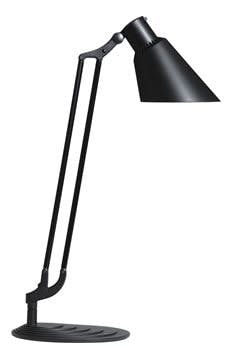Implementing Task Lighting
The best, most effective lighting scheme for your facilities likely involves a mix of overhead lighting and task lighting. Instead of relying heavily on one or the other, a mix of both can save energy, slash operating costs, and help tenants/occupants get more done during the workday.
Options
Task-lighting choices range in terms of fixtures and lamp technology. The fixtures can be mounted to overhead storage bins; the other option is a personal task light. Personal task lights are mounted to a base, or can be mounted to other surfaces (a panel, a rail, the wall, etc.) to free up the desktop. In many cases, under-bin lighting offers little light control, and it can produce direct and indirect glare, causing some professionals to consider under-bin lighting as accent lighting vs. task lighting.
Lamp options include halogen, incandescent, fluorescents, and LEDs. Compact fluorescents and LEDs are the most efficient options of the group. "LEDs are certainly making strides, and are the light of the future," says Shane Cohen, global product manager at New York City-based Humanscale, "but they don't offer the performance of compact fluorescents in terms of energy efficiency and light quality." When it comes to compact fluorescents, Jeff Charon, product manager at Caledonia, MI-based Details, recommends electronic ballasts vs. magnetic ballasts. "They're more energy efficient, and they operate at higher frequencies, so they minimize or eliminate the chance of electronic interference with a computer screen, etc."
FeaturesThe more movement a task light offers, the better, says Charon. "Multiple points of articulation are the first thing I would look for," he says. Light quality is another consideration. "You want a task light that includes some type of lens to distribute the light equally; you're trying to minimize and eliminate contrast."
Cohen says the fixture should easily move with one hand (without the need to adjust knobs), provide a large lighting footprint, remain cool to the touch, not cause multiple shadows (a problem for some LED units), and offer around 100 footcandles in workspaces where documents are read.
Alan Hedge, professor at Ithaca, NY-based Cornell University's Department of Design and Environmental Analysis, also recommends that task lights be dimmable and flicker free, and offer good color rendering (a color rendering index of greater than 85).
Benefits
According to Cohen, the idea of "dual-source lighting" (reducing overhead lighting to 25 footcandles, and using task lights at every workstation) has many advantages. "Research from Rensselaer Polytechnic Institute shows that subjects prefer an office space with dual-source lighting," he says. This research also demonstrates that a dual-source lighting plan uses 35- to 42-percent less energy. Other research projects have indicated similar (or greater) energy-reduction results.
Proper ergonomics is another task-lighting advantage. "When there's not enough light, or there's too much contrast, your eyes become fatigued. Sometimes it leads to loss of productivity, and sometimes it can turn into a medical issue," says Charon. In addition to reducing eyestrain, task lights prevent awkward bending and leaning to find appropriate lighting to perform tasks. Cohen says that reading on paper requires five-times more light than looking at a monitor; therefore, almost every office worker needs ambient lighting for proper monitor viewing, and task lighting for paper.
Leah B. Garris ([email protected]) is managing editor at Buildings magazine.
